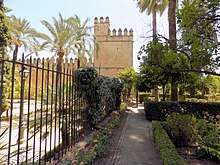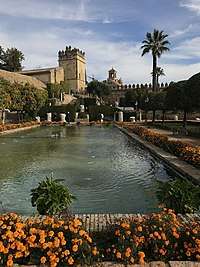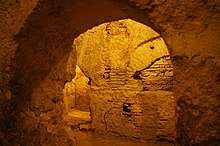Alcázar de los Reyes Cristianos
The Alcázar de los Reyes Cristianos (Spanish for "Castle of the Christian Monarchs"), also known as the Alcázar of Córdoba, is a medieval alcázar (Arabic: القصر, romanized: Al-Qasr, lit. 'The Palace') located in the historic centre of Córdoba (in Andalusia, Spain), next to the Guadalquivir River and near the Grand Mosque. The fortress served as one of the primary residences of Isabella I of Castile and Ferdinand II of Aragon.
.jpg)
It is a building of military character whose construction was ordered by the King Alfonso XI of Castile in the year 1328, on previous constructions (the Al-Andalusian Alcázar, also previous residence of the Roman Governor and the Customs). The architectural ensemble has a sober character in its exterior and splendid in its interior, with the magnificent gardens and courtyards that maintain a Mudéjar inspiration.
The Alcázar has been declared a Cultural Interest Heritage since 1931.[1] It forms part of the Historic Center of Córdoba that was declared a World Heritage Site by UNESCO in 1994.[2]
History

In early medieval times, the site was occupied by a Visigoth fortress. When the Visigoths fell to the Umayyad conquest of Hispania, the emirs of the Umayyad Caliphate in Damascus rebuilt the structure. The Umayyads fell to the Abbasid Caliphate and the surviving member of the Umayyad Dynasty, Abd ar-Rahman I, fled to Córdoba. Abd ar-Rahman I's successors established the independent Caliphate of Córdoba and used the Alcázar as their palace. The city subsequently flourished as a key political and cultural center, and the Alcázar was expanded into a very large and widely used area with baths, gardens, and the largest library in the West.[3] Watermills on the nearby Guadalquivir powered water lifting to irrigate the extensive gardens.
In 1236, Christian forces took Córdoba during the Reconquista. In 1328, Alfonso XI of Castile began building the present day structure on part of the site for the old fortress.[4] Other parts of the Moorish Alcázar had been given as spoils to the bishop, nobles, and the Order of Calatrava.[3] Alfonso's structure retained only part of the Moorish ruins but the structure appears Islamic due to Alfonso's use of the Mudéjar style.
The Alcázar was involved in the civil war where Henry IV of Castile faced a rebellion that backed his teenage half-brother Alfonso. During the war, the Alcázar's defenses were upgraded to deal with the advent of gunpowder. At the same time, the Alcázar's main tower, now known as the "Tower of the Inquisition" was constructed.[3]
Henry's successor, Isabella and her husband, Ferdinand, used the Alcázar for one of the first permanent tribunals of the Spanish Inquisition and as a headquarters for their campaign against the Nasrid dynasty in Granada, the last remaining Moorish kingdom in the Iberian Peninsula. The Inquisition began using the Alcázar as one of its headquarters in 1482, converting much of it, including the Arab baths, into torture and interrogation chambers. The Inquisition maintained a tribunal here for three centuries. Boabdil was held prisoner here in 1483 until he promised to make Granada a tributary state.[5] When Boabdil refused to surrender his kingdom in 1489, the Christians launched an attack. Isabella and Ferdinand's campaign against Granada succeeded in 1492. The same year, the monarchs met Christopher Columbus in the Alcázar as he prepared to take his first voyage to the Americas.[4]
The Alcázar served as a garrison for Napoleon Bonaparte's troops in 1810. In 1821, the Alcázar became a prison. Finally, the Spanish government made the Alcázar a tourist attraction and national monument in the 1950s.[3]
Exterior
Towers

The outdoor area of the Alcázar is situated within the walls of the four towers (Paloma, Leones, Homenaje and Inquisición), this creating an almost square shape to the building.[6]
- Tower of Homage (La torre del Homenaje), of octagonal shape, is situated in the Northeast corner. The tower was previously known as ‘The Clock Tower’ (Torre del Reloj), owing its name to the clock that was previously house within.[7]
- Tower of the Lions (La torre de los Leones), of square shape, is situated in the Northwest corner. The door to the base of this tower is currently used as the visitor entrance to the Alcázar.[7] It is the longest standing tower, dating back to the 13th Century, and is named after gargoyles in the shape of lions which are found on the uppermost section of the tower. Within the tower there are two floors; the ground floor, where the reception can be found, and the upper level which accommodates the Chapel of San Eustaquio (La capilla de San Eustaquio), which served as the chapel to the Catholic Kings.[8][9][8]
- Tower of the inquisition (La torre de la Inquisición), of circular shape, is situated in the Southwest corner. It receives its name from the fact that, for centuries, it housed the archives of the Tribunal of the Holy Inquisition (Tribunal de la Santa Inquisition).[10] It was also known as the ‘Tower of the Gardens’ (Torre de los Jardines’).[10]
- Tower of the Dove (La torre de la Paloma), of square shape, is situated in the Southeast corner. The original tower was demolished in the mid-19th century, the current tower being a reconstruction which dates back to the second half of the 20th century. It was also known as ‘The Watch Tower’ (Torre de la Vela).[11]
Interior
Hall of Mosaics (Salón de los Mosaicos)
The main hall of the building, constructed in the 18th century, is referred to as the “Hall of Mosaics”, given the impressive Mosaics that can be found within the hall. The mosaics on show were discovered at the Corredera Square (Plaza de la Corredera) towards the end of the 1950s and formed part of the Roman Circus, as well as a sarcophagus from the 3rd Century. The hall is currently a highly sought after civil marriage location by many Cordoban citizens.[6][12]
Beneath the current floor of the hall, it is still possible to discover the remains of which are believed to be from the Royal Baths which were used by high dignitaries during the Muslim era.
Courtyard of the Moriscos (Patio Morisco)
The courtyard of the Moriscos, also known as the Mudejar Courtyard, is situated to the western side of the Alcázar. Taking on a square floor plan, it is surrounded by arched verandas with the exception of its western face. The western face of the patio is where the wall that connects the Tower of the Lions and the Tower of the Inquisition is found, and also through which the Gardens of the Alcázar (Jardines del Alcázar) can be accessed. The patio is centred by a water fountain which sits in-between two ponds.
Courtyard of the Women (Patio de las mujeres)
The courtyard of the Women, also known as the eastern courtyard, is situated to the eastern side of the Alcázar. It owes its name to the era during which the Alcázar was used as a prison, with this courtyard being the location where the feminine section of the prison was located. Many archaeological remains from the different constructive phases of the Alcázar are found in this courtyard, as well as remains of former buildings, the Roman castellum and the Andalusian Alcázar.[13]
Reception Hall (Sala de recepciones)
The reception hall, also known as the Ocean Hall, is a room of square plan which is situated beside the Hall of Mosaics.[14] Incrusted in one of the walls is a Roman mosaic, dedicated to the God Oceanus.[14] Also within the hall are found some seats of honor of the ancient chapter choir which date back to the 17th Century.[14]
Royal Baths of Doña Leonor (Baños reales de Doña Leonor)

The Royal Baths were constructed in 1328 by King Alfonso the 11th.[15] They were structured into four rooms: the changing room, the cold room, the temperate room and the hot room.[15] They owe their name to Leonor de Guzmán, the King's mistress, in whose honour the Royal Baths were constructed.[15]
Gardens of the Alcázar (Jardines del Alcázar)
The old Alcázar orchard has been transformed into an impressive area of approximately 55,000m² of magnificent gardens with forest species including palm, cypress, orange and lemon trees, which surround a number of elegant fountains and ponds. The gardens are structured on three levels: the upper garden, the middle garden and the lower garden.
The King's walk (El paseo de los reyes) is a walk bordered by a line of cylindrical cypress trees and is also divided into two paths by two narrow ponds. On this walk, there are several sculptures of the Kings who built the Alcázar, which are located on pedestals aligned between the hedges.[16]
Description
The Alcázar centers on the Patio Morisco ("Courtyard of the Moriscos"), another popular feature. There are two towers: the Torre de los Leones ("Tower of the Lions) and the Torre de Homenaje ("Tower of Homage"). The latter has Gothic features including an ogival ceiling.[4]
A series of Roman mosaics and a Roman sarcophagus are displayed in the Inquisition Tower.
References
- "Real Estate database registered in the Register of Assets of Bienes de Interés Cultural (search by typing "Alcázar Nuevo" in the "General" field)". Official website of the Ministry of Culture of Spain. 2013-06-12.
- "Historic Center of Córdoba". UNESCO Culture Sector.
- Reed, Tony (2005). "Alcazar de los Reyes Cristianos – Córdoba". Infocordoba.com. Archived from the original on 11 May 2006. Retrieved April 4, 2006.
- "Alcázar de los Reyes Cristianos". Frommer's. Retrieved April 4, 2006.
- "Alcázar de los Reyes Cristianos". Fodor's. Retrieved April 4, 2006.
- "Alcázar de los Reyes Cristianos – cordobaturismo.es". cordobaturismo.es (in Spanish). Retrieved 2018-03-07.
- "Descripción del Alcázar de los Reyes Cristianos, Córdoba". ArtenCórdoba Visitas Guiadas (in Spanish). Retrieved 2018-03-07.
- Farfán, Lourdes María Morales. "Córdoba: El Alcázar de los Reyes Cristianos". unaventanadesdemadrid.com. Retrieved 2018-03-07.
- "Torre de la Inquisición".
- "El Salón de los Mosaicos".
- "Patio de las mujeres".
- "Salón de los Mosaicos – Alcázar de los Reyes Cristianos, Córdoba". ArtenCórdoba Visitas Guiadas (in Spanish). Retrieved 2018-03-07.
- "Audiodescripción de los Baños Reales de Doña Leonor".
- "Paseo de los Reyes".
- "Los Baños reales de Doña Leonor - Alcázar de los Reyes Cristianos | Visita Virtual".
- "Paseo de los Reyes (1 de 2) - Alcázar de los Reyes Cristianos | Visita Virtual".
External links
| Wikimedia Commons has media related to Alcázar de los Reyes Cristianos. |

